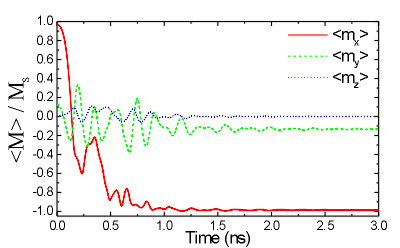µMAG Standard Problem #4 results
See the problem specification.
Disclaimer
µMAG could not succeed without the contributions
of colleagues working outside NIST. Although we value the
contributions made by these colleagues, NIST does not necessarily
endorse the views expressed or the data presented in the submitted
solutions shown below.
Solution directory
-
Comparisons
- G. Albuquerque,
J. Miltat and A. Thiaville
-
R. D. McMichael, M. J. Donahue, D. G. Porter, and
J. Eicke
-
Liliana Buda, Lucian Prejbeanu, Ursula Ebels and Kamel
Ounadjela
-
E. Martinez, L. Torres and L. Lopez-Diaz
-
José L. Martins and Tania Rocha
-
P.E. Roy and P. Svedlindh
-
Massimiliano d’Aquino, Claudio Serpico,
and Giovanni Miano
-
Dmitri Berkov
-
M. J. Donahue and D. G. Porter
-
Rasmus Bjørk, E. B. Poulsen and A. R. Insinga
Submitted Solution:
Liliana Buda, Lucian Prejbeanu, Ursula Ebels and Kamel Ounadjela
- Date:
- November 27, 2000
- From:
- Liliana Buda, Lucian Prejbeanu, Ursula Ebels and Kamel Ounadjela
Institut de Physique et Chimie des Matériaux
Groupe d'Etude des Matériaux Métalliques
23, rue du Loess, 67037 Strasbourg Cedex, France
- Contact:
- L. D. Buda
A 3D code has been used for these numerical investigations.
The ferromagnetic system is discretized in
Nx ×
Ny ×
Nz
identical tetrahedral cells having the size
hx ×
hy ×
hz. The studies
presented here implies a single cell across the thickness.
Inside each cell the magnetization is assumed to be uniform.
The stray field is evaluated as the average over the magnetic
cell [see A. J. Newell, W. Williams, and D. J. Dunlop, J. Geophys.
Res. 98, 9551 (1993) and A. Hubert, R. Schäfer, Magnetic
Domains, Springer-Berlin, p. 148 (1998)]. The demagnetization field
and energy are computed using the FFT method (FFTW subroutines).
The exchange interaction approximation is the "7-point formula"
applied to the 3D case [see Y. Nakatani, N. Uesaka and N. Hayashi,
J. Appl. Phys. 28, 2485 (1989)]. On the free surfaces of
the magnetic system the magnetization fullfills the Neumann boundary
conditions.
For the integration of the LLG equation the implicit
Crank-Nicholson backward scheme is used. Our algorithm uses a
constant time step of less than 0.1 ps. After each iteration the
magnetization is renormalized in order to satisfy the ferromganetic
condition.
The convergence criteria imposes that the residual torque (the
maximum value of the torque) to be less than 10-6.
Results:
After applying the field at 170° from the x-axis
(Field 1):

The time evolution of the magnetization components average calculated using 5.0 nm
cells.

The magnetization distribution corresponding to the < Mx > = 0.

The effects of the mesh size on the time evolution of the magnetization.
-
After applying the field at 190° from the x-axis (Field 2):

The time
evolution of the magnetization components average calculated using 5.0
nm cells.

The magnetization distribution corresponding to the < Mx > = 0.

The effects of the mesh size on the time evolution of the magnetization.
Raw data:
Time series data contain 10 columns: time (ns), residual torque, demagnetization energy (erg/cc),
exchange energy (erg/cc), anisotropy energy (erg/cc), Zeemann energy (erg/cc), total energy (erg/cc),
m_x, m_y, m_z. Vector data has 6 columns: x, y, z
coordinates, and m_x, m_y, m_z vector components.
References:
L. D. Buda, I. L. Prejbeanu, M. Demand, U. Ebels and K. Ounadjela,
The 8th Joint MMM-Intermag Conference 2001
Proceedings
Please send comments to [email protected] and join the
µMAG discussion e-mail list.
Site Directory
µMAG organization / NIST CTCMS /
[email protected]
11-NOV-2021


